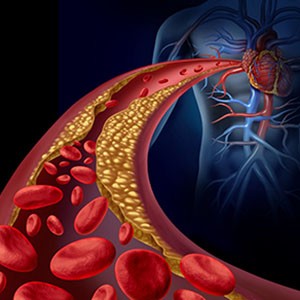-
05 FEB 15
Dyslipidaemia (Cholesterol) - Cardiovascular Risk - Hypertension – Thrombophilia
 Lipids and cholesterol are largely responsible for the gradual narrowing of blood vessels, indirectly threatening with obstructive diseases, mainly affecting the heart (with myocardial infarction), the brain (risk of stroke), as well as the lungs (risk of pulmonary embolism).
Lipids and cholesterol are largely responsible for the gradual narrowing of blood vessels, indirectly threatening with obstructive diseases, mainly affecting the heart (with myocardial infarction), the brain (risk of stroke), as well as the lungs (risk of pulmonary embolism).
The process of building up plaque in the vessels is a slow and long-term process correlated with lipid levels in the blood. Therefore, cholesterol is used as a long-term risk indicator for atherosclerotic disease.To assess possible dyslipidaemia and calculate the risk of coronary artery disease due to it, the measurement of multiple parameters is required. Thus, it is suggested to measure:
- Cholesterol (Chol): Represents the total cholesterol derived from diet and endogenously produced by the liver.
- High-Density Lipoprotein Cholesterol (HDL): The protective "good" cholesterol that we want to be as high as possible. Its regulation is achieved through good nutrition, exercise, and smoking cessation.
- Low-Density Lipoprotein Cholesterol (LDL): The harmful "bad" cholesterol, mainly regulated by diet and then pharmacologically if necessary.
- Very Low-Density Lipoprotein Cholesterol (VLDL): A portion of lipids evaluated independently.
- Triglycerides (Trig): Lipids highly dependent on diet and fats consumed. Elevated levels are evaluated in choosing hypolipidemic therapy.
- Total lipids: The sum of lipids associated with atherosclerotic disease and cardiovascular risk.
- Atherogenic index: The ratio of cholesterol to HDL, indicating the degree to which HDL protects blood vessels and the heart from the effects of cholesterol.
- Lipoprotein-a [Lp(a)]: An independent lipid that serves as an additional marker of atherosclerosis and cardiovascular disease.
- Apolipoprotein A1 (Apo-A1): Provides information on the protective capacity of HDL.
- Apolipoprotein B (Apo-B and Apo-B100): Provides information on the harmfulness of LDL.
- Apolipoprotein E (Apo-E): Assessed to estimate specific types of dyslipidaemia and the effectiveness of statin therapy.
For those with dyslipidaemia issues, cardiovascular risk assessment is also recommended, especially in cases of a family history of cardiovascular disease, or if the individual is overweight, diabetic, hypertensive, or a smoker.
As preparation for morning blood sampling and examination, the following is suggested:
- A meal must be consumed the previous evening.
– The last meal should be consumed up to 11-12 hours before blood sampling.
– The evening meal should contain fewer animal fats (if it includes cheeses, fatty dairy products, and meats).
- In the morning, only coffee should be consumed, with free water intake.-
Σχετικές εξετάσεις
-

Haematological Examination
Anaemias can primarily originate from: Chronic diseases, e.g., neoplasias. Blood loss (mainly from the gastrointestinal tract). Poor nutrition – deficiency of hematopoietic elements (e.g., prolonged diets deficient in animal products). Dysplasia – aplasia of the bone marrow – haematological disorders (e.g., inherited hemoglobinopathies, such as thalassemia or "stigma," sickle cell anaemia, hereditary spherocytosis). Prolonged immobility. Renal insufficiency. Autoimmune diseases. Use of medications that suppress the bone marrow.
-

Dyslipidaemia (Cholesterol) - Cardiovascular Risk - Hypertension – Thrombophilia
Lipids and cholesterol are largely responsible for the gradual narrowing of blood vessels, indirectly threatening with obstructive diseases, mainly affecting the heart (with myocardial infarction), the brain (risk of stroke), as well as the lungs (risk of pulmonary embolism).
-

Thyroid examination
The thyroid gland is a crucial organ in regulating metabolism. The hormones it produces (T3 and T4) are absorbed by all cells in the body and regulate their metabolic rate. Overactivity of the gland, i.e., high production of T3 and T4, is associated with nervousness, poor sleep, hypertension, tachycardia, excessive sweating, tremors in the hands, confusion, unexplained weight loss, etc.
-

Helicobacter pylori infection test
Helicobacter pylori infection is easily transmitted from person to person through the oral-faecal route, even via breath aerosols. Thus, if one person carries the infection, it is almost certain that the infection is present in both members of a couple or even in all members of a family.
-

Sexually Transmitted Diseases Assessment
Sexually transmitted diseases are screened preventively, as their transmission usually occurs from individuals who are unaware that they are infected. This happens because the time for the clinical symptoms and discomfort to appear ranges from a few months to several years.





